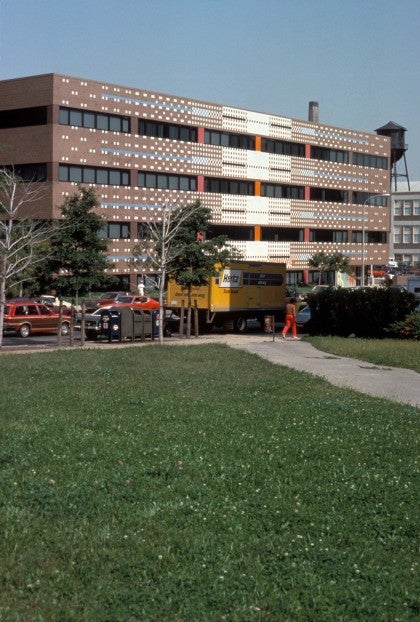| Sorted by date | |||
page155from Building Ideas
9 Michael Graves – San Juan Capistrano
Library, California, 1982. (Neil Jackson)
The fact that building elements are
nameable objects, such as arch, column and floor meant that they were also
memorable to the building user as a way of establishing a sense of place.
Graves felt this quality had been lost in the abstractions of modernist geometries,
where points, lines and planes no longer allowed this kind of reading. The
shortcomings in Graves’ buildings, however, result from a different kind of
abstraction, where the abrupt shifts of scale disrupt conventional
expectations. The curious combination of historical quotations, whose
volumetric quality is denied by the thinness of their construction, results in
a feeling of superficial unreality that belies the gravity of Graves’s theoretical
position.
|
|||
|
|||
|
|
|||
page154from Building Ideas
8 Michael Graves – San Juan Capistrano
Library, California, 1982. (Neil Jackson)
|
|||
|
|||
|
|
|||
page153from Building Ideas
6 Michael Graves – Humana Building,
Louisville, Kentucky, 1982-86. (Jonathan Hale)
7 Michael Graves – Humana Building,
Louisville, Kentucky, 1982-86. (Jonathan Hale)
on associational readings, where both
figurative and anthropomorphic references are of major significance.
Graves
blamed the lack of this kind of reference for the alienation of modernist
space, as he claimed that buildings no longer acted as mediators between human
beings and their environment:
All
architecture before the modern movement sought to elaborate the themes of man
and landscape. Understanding the building involves both association with
natural phenomena( for example, the ground is like the floor), and
anthropomorphic allusions ( for example, a column is like a man). These two
attitudes within the symbolic nature of building were probably originally in
part ways of justifying the elements of architecture in a pre-scientific
society. However, even today, the same metaphors are required for access to our
own myths and rituals within the building narrative.18
|
|||
|
|||
|
|
|||
page152from Building Ideas
making great play of the fact that it is
merely trying to refer to something else.
The
problem with this reduction of architecture to decoration is that people still
have to inhabit the internal spaces of the “shed”. Another architect who has
also tried to make sense of this dilemma, and who shares the concern with
history expressed by Venturi, is fellow American Michael Graves. Graves became
known in the 1970s as one of the famous New York Five, after the book Five
Architects published in 1972. At this stage, paradoxically, his work showed
pronounced “syntactic” tendencies, being for the most part of revival of 1920s
modernist forms. Beginning with the abstract geometric language of Le Corbusier’s
“purist” villas, Graves was just beginning to experiment by adding colour and
fragmenting forms.
Following
a period of study in Rome at the American Academy and the phenomenological
influence of his colleague Peter Carl, his buildings also began to include more
obviously figurative elements, along with the explicit quotation of historical
references. In the essay accompanying his work, published in 1982, he made use
of the language analogy to illustrate his interest in meaning. By
distinguishing between the everyday and the poetic dimensions of language, he
was also echoing Broadbent’s division between syntactic and semantic:
When
applying this distinction of language to architecture, it could be said that
the standard form of building is its common or internal language – determined
by pragmatic, constructional and technical requirements. In contrast, the
poetic form of architecture is responsive to issues external to the building,
and incorporates the three-dimensional expression of the myths and rituals of
society.17
Graves went on to admit that both
dimensions of meaning are essential, but he concentrates on the latter as a
reaction to its neglect in mainstream modernism. This poetic, or external,
language is dependent
|
|||
|
|||
|
|
|||
page151from Building Ideas
5 Venturi, Rauch and Scott-Brown –
Institute for Scientific Information, Philadelphia, 1978-79.(Alistair Gardner)
|
|||
|
|||
|
|
 ... ...
... ... ... ...
... ... ... ...
... ... ... ...
... ... ... ...
... ... ... ...
... ... ... ...
... ... ... ...
... ... ... ...
... ... ... ...
... ... ... ...
... ... ... ...
... ... ... ...
... ... ... ...
... ... ... ...
... ...


